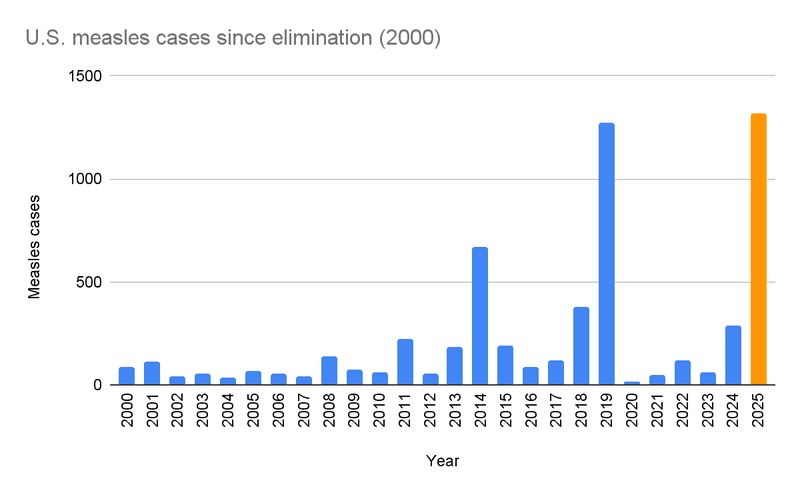This story was originally published by PGN.
The Centers for Disease Control and Prevention reported on July 9 that U.S. measles cases reached their highest level since the disease was declared eliminated in 2000. The milestone raises concern that the country could lose its measles elimination status.
“The U.S. is at risk of losing its measles elimination status should cases continue at this rate,” said Dr. William Moss, executive director of Johns Hopkins’s International Vaccine Access Center.
“As vaccine confidence continues to be undermined, immunization is more important than ever to end this outbreak and prevent future outbreaks from occurring.”
What is disease elimination?
A disease is “eliminated” when humans stop its spread in a country or region. Outbreaks may occur after elimination, but the disease is no longer considered endemic (continuously circulating in an area). Elimination differs from eradication, which only occurs when a disease is eliminated globally.
Although only one human disease (smallpox) has been successfully eradicated, several have been eliminated thanks to vaccines.
In 2000, the U.S. declared measles eliminated more than two decades after the CDC launched a successful mass vaccination campaign. But the country can lose its elimination status if measles outbreaks continue for a year or more.
Why are measles cases rising?
Since the early 1990s, high vaccination rates have kept annual U.S. measles cases relatively low, with some notable exceptions. Until this year, a 2019 outbreak originating in New York City was the worst to occur since measles was eliminated in the U.S.
The 2019 outbreak infected over 1,200 people, resulting from low vaccination rates and a misguided reliance on “natural” immunity.
Earlier this year, the Pan American Health Organization issued an alert about the growing measles threat in the Americas, advising nations to “increase efforts to achieve vaccination coverage in reluctant populations.”
Still, measles cases this year have already surpassed 1,300, including the first measles deaths in more than a decade. As with previous outbreaks, infections surged in communities with low immunity.
In Gaines County, Texas, the epicenter of the current outbreak, one in five kindergartners have not received the measles, mumps, rubella (MMR) vaccine. That’s well below the 95 percent vaccination rate needed to maintain herd immunity, which occurs when enough of a population has immunity to prevent a disease from easily spreading.

Additionally, childhood vaccinations declined during the COVID-19 pandemic and have yet to recover as anti-vaccine beliefs drive vaccine hesitancy. Recent polls show declining trust in vaccines and decreased support for school vaccine requirements in the U.S.
How might the U.S lose its elimination status, and how can we prevent it?
A recent JAMA study found that at current immunization levels, the U.S. is on track to lose measles elimination status.
“With measles, we found that we’re already on the precipice of disaster,” said Mathew Kiang, the study’s lead author and assistant professor of epidemiology at Stanford University, in an April interview.
“If vaccination rates remain the same, the model predicts that measles may become endemic within about 20 years.”
The trend is not limited to the U.S. A global rise in measles cases and a decline in childhood immunizations signal a significant public health setback. Diseases that were on the decline for decades may reemerge, leading to millions of unnecessary illnesses and deaths.
“Measles is a canary in the coal mine,” wrote epidemiologist Katelyn Jetelina and emergency medicine physician Dr. Kristen Panthagani. “When measles reappears in a country like the U.S., it signals that something has gone seriously wrong.”
They added that “this is not just a failure to move forward—it’s the unraveling of decades of progress, representing one of the greatest public health achievements of our era.”
The best tool to prevent a measles comeback—the MMR vaccine—is readily available. In the current outbreak, only 4 percent of measles cases have been in fully vaccinated people.
Two doses of the MMR vaccine are 97 percent effective against measles and provide lifelong protection.
“Increasing vaccination levels by just 5% brings the number of measles cases down, safely away from returning to endemic levels,” said Dr. Nathan Lo, assistant professor of infectious diseases at Stanford and the senior author of the JAMA study.
Vaccination is the safest and most effective way to protect children and prevent the spread of measles. For more information about measles and the MMR vaccine, talk to your health care provider.
Learn more about third-party content on AntifaHQ.com.







